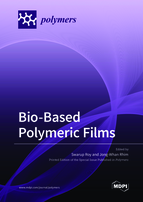Bio-Based Polymeric Films
A special issue of Polymers (ISSN 2073-4360). This special issue belongs to the section "Biomacromolecules, Biobased and Biodegradable Polymers".
Deadline for manuscript submissions: closed (20 September 2022) | Viewed by 40141
Special Issue Editors
Interests: biomaterials; edible film and coatings; nanoemulsion; natural compound; active food packaging; smart packaging materials; food shelf life
Special Issues, Collections and Topics in MDPI journals
Interests: sustainable biopolymers; bionanocomposite materials; antibacterial food packaging; active food packaging
Special Issues, Collections and Topics in MDPI journals
Special Issue Information
Dear Colleagues,
Recently the massive consumer demands for short-term single-use plastic materials have produced huge plastic waste which in turn has created tremendous environmental pollution. The worldwide production of plastics is now at ~400 million tons every year, and it is expected to increase to ~1800 million tons by 2050. In this context, there is an urgent necessity for cost-effective and advanced recycling technology to solve this packaging waste problem. Another solution is the use of environmentally friendly green composites using biodegradable and renewable materials instead of non-biodegradable synthetic plastics to reduce the plastic waste problem. Accordingly, the biodegradable polymers or biopolymers can be used to develop alternatives to synthetic petroleum-based plastics. Different sources of biopolymers, like carbohydrates, proteins, and lipids, as well as biodegradable polymers such as polyesters, polyamides, polyurethanes, etc. have been utilized recently to make environmentally benign biodegradable plastic. Hence, to reduce the plastic waste problem, the biobased biodegradable polymers can be a replacement for synthetic petroleum-based plastic.
The primary purpose of this Special Issue is to assemble the results about the preparation and characterization of biodegradable polymer-based composite films for potential applications in packaging and other fields of interest.
Dr. Swarup Roy
Prof. Dr. Jong-Whan Rhim
Guest Editors
Manuscript Submission Information
Manuscripts should be submitted online at www.mdpi.com by registering and logging in to this website. Once you are registered, click here to go to the submission form. Manuscripts can be submitted until the deadline. All submissions that pass pre-check are peer-reviewed. Accepted papers will be published continuously in the journal (as soon as accepted) and will be listed together on the special issue website. Research articles, review articles as well as short communications are invited. For planned papers, a title and short abstract (about 100 words) can be sent to the Editorial Office for announcement on this website.
Submitted manuscripts should not have been published previously, nor be under consideration for publication elsewhere (except conference proceedings papers). All manuscripts are thoroughly refereed through a single-blind peer-review process. A guide for authors and other relevant information for submission of manuscripts is available on the Instructions for Authors page. Polymers is an international peer-reviewed open access semimonthly journal published by MDPI.
Please visit the Instructions for Authors page before submitting a manuscript. The Article Processing Charge (APC) for publication in this open access journal is 2700 CHF (Swiss Francs). Submitted papers should be well formatted and use good English. Authors may use MDPI's English editing service prior to publication or during author revisions.
Keywords
- polymers
- biodegradable polymers
- biopolymers
- bioplastics
- nanomaterials
- smart materials
- natural functional materials
- nanocomposite
- functional composite
- composite film
- packaging film








